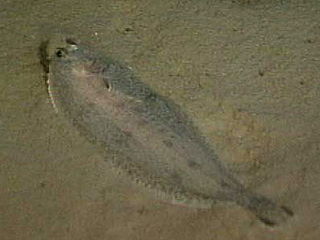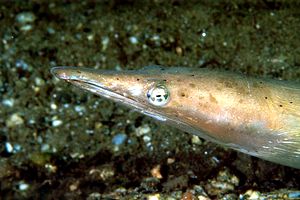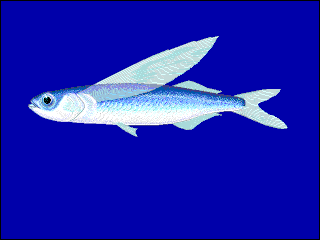
Halosaurs are eel-shaped fishes found only at great ocean depths. As the family Halosauridae, halosaurs are one of two families within the order Notacanthiformes; the other being the deep-sea spiny eels, Notacanthidae. Halosaurs are thought to have a worldwide distribution, with some 17 species in three genera represented. Only a handful of specimens have been observed alive, all in chance encounters with Remotely operated underwater vehicles.

Macroramphosus, snipefishes or bellowfishes, is a genus of fishes found in tropical and subtropical oceans at depths down to 600 metres (2,000 ft). According to FishBase, they are part of the family Centriscidae, but Nelson (2016) split that family, in which case the genus Macroramphosus is in the family Macroramphosidae. They have long second spines on their dorsal fins and tiny mouths at the tip of their greatly elongated snouts. The bodies of snipefish are more streamlined than in the related bellowfishes. They reach a maximum length of about 20 cm (7.9 in), and are silvery or reddish in colour. They are sometimes found in large schools. This is the only genus on the monogeneric family Macroranphosidae but some authorities include the genera Centriscops and Notopogon in this family too.

The blackspot shark is a small species of requiem shark in the family Carcharhinidae found in the tropical Indo-West Pacific Ocean between latitudes 24°N and 30°S, from the surface to a depth around 40 m (130 ft). Its length is a little under one meter (yard) and it is not considered to be dangerous to humans. It feeds mainly on fish, crustaceans, and squid. This shark is also caught in small-scale fisheries for human consumption.

Glyptocephalus cynoglossus, known in English by a variety of common names including the witch, witch flounder, pole flounder, craig fluke, Torbay sole and grey sole, is a species of flatfish from the family Pleuronectidae. It occurs on both sides of the North Atlantic Ocean on muddy sea beds in quite deep water. In northern Europe it has some importance in fisheries as a food fish.

Myrichthys maculosus, commonly known as the tiger snake eel, the ocellate snake eel or the spotted snake eel, is a species of fish in the family Ophichthidae, native to the Indo-Pacific. It is occasionally encountered in the aquarium trade. It grows to a length of 1 m (40 in).

The brownsnout spookfish is a species of barreleye in the family Opisthoproctidae. It and the glasshead barreleye fish are the only vertebrates known to employ a mirror, in addition to a lens, to focus an image in its eyes. This species probably has a worldwide tropical and temperate distribution; in the Atlantic Ocean it is known from Bermuda, the Bahamas, the Greater Antilles, and the Gulf of Mexico, and in the Pacific Ocean it is known from the California Current region and the South China Sea. It is found in the mesopelagic and bathypelagic zones at a depth of 500–2,400 meters (1,600–7,900 ft), but usually occurs below 1,000 meters. In the Gulf of Mexico it is found shallower, at 310–460 meters (1,020–1,510 ft).

Acanthurus polyzona, commonly known as the black-barred surgeonfish or zebra tang, is a tropical fish found in coral reefs in the western Indian Ocean. It was first described in 1868 by the Dutch ichthyologist Pieter Bleeker, who gave it the name Rhombotides polyzona; it was later transferred to the genus Acanthurus, becoming Acanthurus polyzona.

Cirrhibarbis capensis, the barbelled klipfish, is a species of clinid found in subtropical waters of the Atlantic Ocean around South Africa. This species can reach a maximum length of 36 centimetres (14 in) TL. This species preys primarily on benthic crustaceans, mostly amphipods and isopods. It is currently the only known member of its genus.
Blennophis anguillaris, the snaky klipfish, is a species of clinid found in the subtropical waters of the Atlantic Ocean around South Africa. It can be found in the subtidal zone and also is a denizen of tidepools. This species can reach a maximum length of 30 centimetres (12 in) TL.

Blennophis striatus, the Striped klipfish, is a species of clinid found in the subtropical waters of the Atlantic Ocean from Saldanha Bay to East London, South Africa where it can be found in the subtidal zone as well as inhabiting tidepools. This species can reach a maximum length of 17.5 centimetres (6.9 in) TL.
Cancelloxus burrelli, the Slender platanna-klipfish, is a species of clinid found in subtropical waters of the Atlantic Ocean along the South African coast from the Orange River to Algoa Bay in South Africa. It can be found from the intertidal zone down to about 20 metres (66 ft). This species can reach a maximum length of 12 centimetres (4.7 in) TL.
Clinus brevicristatus, the Cape klipfish, is a species of clinid that occurs in subtropical waters of the Atlantic Ocean around South Africa where it prefers habitats with plentiful growth of seaweed. This species can reach a maximum length of 12 centimetres (4.7 in) TL.

Ophisurus is a genus of eels in the snake eel family Ophichthidae. It currently contains the following species:

Dollfus' stargazer is a fish of the family Uranoscopidae, widespread in the Western Indian Ocean: Gulf of Suez, Gulf of Oman, and Persian Gulf. It is a marine demersal fish, and occurs at depths down to about 46 metres (151 ft). It was named in honour of Dr R. P. Dollfus who led an expedition to Egypt in 1928–1929 and who brought back some specimens of this fish which he mistakenly identified as Uranoscopus affinis. These were new to science and became the type specimens of the new species U. dollfusi, with the Gulf of Suez being the type locality.

Menticirrhus americanus, the southern kingfish, southern kingcroaker, king whiting, Carolina whiting, sea mullet, roundhead, or whiting, is a species of marine fish in the family Sciaenidae. It lives in shallow coastal waters on the western fringes of the Atlantic Ocean.

Brachysomophis cirrocheilos, also known as the stargazer snake eel, is a benthic marine fish belonging to the family Ophichthidae. The stargazer snake eel is a large fish which grows up to 159 cm (63 in) long.
The blackspotted hawkfish is a species of marine ray-finned fish, a hawkfish belonging to the family Cirrhitidae. It is native to rocky shores of the western Indian Ocean. This species grows to 17 cm (6.7 in) in total length. This species is the only known member of its genus.

Dysommina rugosa is an eel in the family Synaphobranchidae. It was described by Isaac Ginsburg in 1951. It is a marine, deep water-dwelling eel which is known from the western Atlantic and eastern central Pacific Ocean. It dwells at a depth range of 260–775 metres, and is found off the continental slope. Males can reach a maximum total length of 37 centimetres.

Exocoetus volitans, commonly known as the tropical two-wing flyingfish or blue flyingfish, is a species of ray-finned fish native to tropical and subtropical seas. It can glide above the surface of the sea to escape predators.
Trachurus delagoa, the African scad, is a species of jack mackerel from the family Carangidae which is found in the south western Indian Ocean.
















